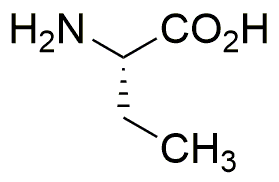L-a-Aminobutyric acid is widely utilized in research focused on:
- Neuroscience: This compound acts as a neurotransmitter and is studied for its role in modulating synaptic transmission, making it valuable for understanding conditions like anxiety and depression.
- Agriculture: It serves as a plant growth regulator, promoting root development and improving stress tolerance in crops, which can lead to higher yields and better quality produce.
- Pharmaceuticals: Used in the synthesis of various drugs, it has potential applications in developing treatments for neurological disorders due to its neuroprotective properties.
- Food Industry: As a flavor enhancer, it can improve the taste profile of certain food products, appealing to manufacturers looking to enhance consumer satisfaction.
- Biotechnology: In cell culture, it is utilized to support the growth of specific cell lines, aiding researchers in developing new therapies and conducting experiments more effectively.
Información general
Propiedades
Seguridad y normativas
Aplicaciones
L-a-Aminobutyric acid is widely utilized in research focused on:
- Neuroscience: This compound acts as a neurotransmitter and is studied for its role in modulating synaptic transmission, making it valuable for understanding conditions like anxiety and depression.
- Agriculture: It serves as a plant growth regulator, promoting root development and improving stress tolerance in crops, which can lead to higher yields and better quality produce.
- Pharmaceuticals: Used in the synthesis of various drugs, it has potential applications in developing treatments for neurological disorders due to its neuroprotective properties.
- Food Industry: As a flavor enhancer, it can improve the taste profile of certain food products, appealing to manufacturers looking to enhance consumer satisfaction.
- Biotechnology: In cell culture, it is utilized to support the growth of specific cell lines, aiding researchers in developing new therapies and conducting experiments more effectively.
Documentos
Hojas de datos de seguridad (HDS)
La SDS proporciona información de seguridad completa sobre la manipulación, el almacenamiento y la eliminación del producto.
Especificación del producto (PS)
La PS proporciona un desglose completo de las propiedades del producto, incluida la composición química, el estado físico, la pureza y los requisitos de almacenamiento. También detalla los rangos de calidad aceptables y las aplicaciones previstas del producto.
Certificados de análisis (COA)
Busque certificados de análisis (COA) ingresando el número de lote del producto. Los números de lote y de partida se pueden encontrar en la etiqueta de un producto después de las palabras "Lote" o "Lote".
Número de catálogo
Número de lote/lote
Certificados de origen (COO)
Este certificado de origen confirma el país en el que se fabricó el producto y también detalla los materiales y componentes utilizados en él y si se deriva de fuentes naturales, sintéticas u otras fuentes específicas. Este certificado puede ser necesario para cumplir con las normativas aduaneras, comerciales y regulatorias.
Número de catálogo
Número de lote/lote
Hojas de datos de seguridad (HDS)
La SDS proporciona información de seguridad completa sobre la manipulación, el almacenamiento y la eliminación del producto.
DownloadEspecificación del producto (PS)
La PS proporciona un desglose completo de las propiedades del producto, incluida la composición química, el estado físico, la pureza y los requisitos de almacenamiento. También detalla los rangos de calidad aceptables y las aplicaciones previstas del producto.
DownloadCertificados de análisis (COA)
Busque certificados de análisis (COA) ingresando el número de lote del producto. Los números de lote y de partida se pueden encontrar en la etiqueta de un producto después de las palabras "Lote" o "Lote".
Número de catálogo
Número de lote/lote
Certificados de origen (COO)
Este certificado de origen confirma el país en el que se fabricó el producto y también detalla los materiales y componentes utilizados en él y si se deriva de fuentes naturales, sintéticas u otras fuentes específicas. Este certificado puede ser necesario para cumplir con las normativas aduaneras, comerciales y regulatorias.


